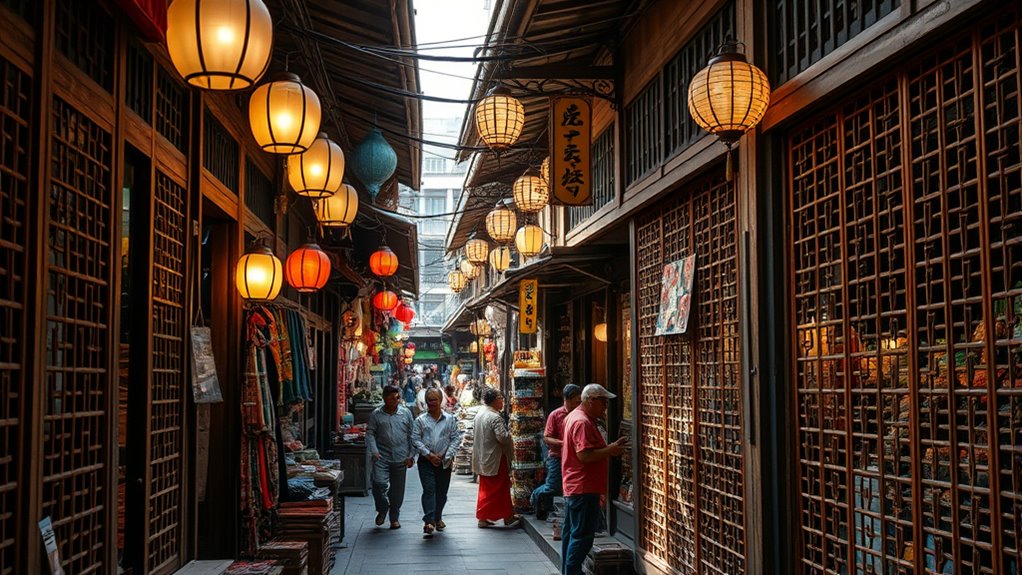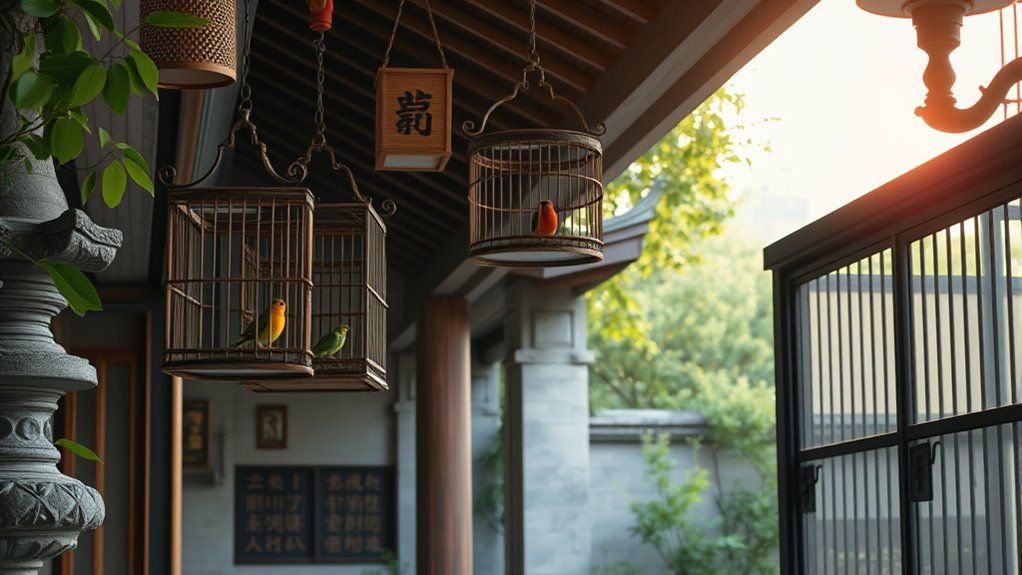Confinement practices in Asia are rich in tradition, deeply rooted in history and cultural values. You’ll find customs centered on rest, herbal remedies, rituals, and community involvement across regions like East, South, and Southeast Asia. These practices aim to protect women’s health, strengthen social bonds, and reinforce cultural identity. As practices evolve with modern influences, exploring these traditions reveals how they shape postpartum care across Asia—continue to discover the fascinating details behind these enduring customs.
Key Takeaways
- Asian confinement practices have deep cultural roots emphasizing postpartum rest, herbal remedies, and rituals to promote health and social harmony.
- Rituals vary regionally but commonly include dietary restrictions, massages, herbal treatments, and staying indoors for weeks.
- Family and community involvement are vital, reinforcing cultural traditions and social bonds during the postpartum period.
- Modern adaptations integrate technology, shorter confinement durations, and holistic health approaches while maintaining traditional values.
- Compared to global norms, Asian practices strongly focus on balance, cultural identity, and community support for postpartum recovery.
Historical Roots and Cultural Significance of Confinement in East Asia

Confinement practices in East Asia have deep historical roots that reflect the region’s cultural values and social structures. Historically, these practices centered on filial piety, family loyalty, and social harmony. In ancient China, confinement was often seen as a way to protect women’s virtue during and after childbirth, emphasizing their role within the family and society. Confucian ideals reinforced the importance of obedience, modesty, and respect for elders, shaping confinement customs. Similarly, in Korea and Japan, confinement was intertwined with traditional beliefs about health, morality, and social order. These practices weren’t just about physical confinement but also symbolized social stability, gender roles, and the preservation of cultural identity. Over centuries, they became embedded in societal expectations and cultural norms. Additionally, these confinement customs often served to uphold traditional gender roles, further reinforcing societal expectations and cultural continuity.
Traditional Confinement Practices in South Asia

In South Asia, traditional confinement practices involve specific rituals and ceremonies that mark this important period. You’ll notice strict dietary restrictions and fasting, believed to support recovery and well-being. Postnatal care customs also emphasize rest, warmth, and special care for both mother and baby. Additionally, some communities are adopting cybersecurity awareness to protect digital health records during this vulnerable time.
Rituals and Ceremonies
Traditional confinement practices in South Asia are deeply rooted in rituals and ceremonies that mark the progression of a new mother and her baby into family life. These rituals often involve sacred rites performed by elders or community leaders to bless the mother, ensuring her recovery and the child’s well-being. Ceremonies may include special prayers, blessing rituals, and symbolic gestures like lighting lamps or offering grains. Family members gather to celebrate this new chapter, emphasizing cultural values and spiritual protection. These ceremonies reinforce social bonds and honor ancestral traditions, providing a sense of continuity and identity. You may participate in these rituals to honor your heritage, and they serve as meaningful milestones that signify the transition into motherhood within the cultural fabric. The use of traditional confinement practices can also promote emotional support and community cohesion during this important life event.
Dietary Restrictions and Fasting
Have you ever wondered why new mothers in South Asia often follow specific dietary restrictions during their confinement period? These practices are rooted in traditional beliefs that certain foods can influence recovery and future health. During this time, mothers typically avoid cold, greasy, or spicy foods, believing they can cause imbalance or illness. Instead, they consume warm, easily digestible foods like soups, stews, and herbal teas that promote healing and milk production. Fasting is also common, either to purify the body or honor spiritual traditions. These dietary restrictions aren’t just about nutrition; they reflect cultural values emphasizing rest, preservation, and protection for both mother and baby. Following these practices helps women recover physically and reconnect with cultural identity during the vulnerable postpartum period. Additionally, some communities incorporate traditional health practices such as herbal remedies and specific rituals to enhance recovery and well-being.
Postnatal Care Customs
Postnatal care customs in South Asia are deeply rooted in cultural beliefs that emphasize restoring balance and ensuring the mother’s well-being. You may be encouraged to stay in bed for weeks, avoiding physical exertion and cold foods. Traditional practices include applying herbal pastes, massages, and warm compresses to aid recovery and promote milk production. You might also follow rituals like ear and navel binding or avoiding bathing to protect your energy and prevent illness. Family members play a vital role, providing nourishment and emotional support. These customs aim to restore yin and yang, maintaining harmony within the body. By adhering to these practices, you help guarantee a smoother transition into motherhood and safeguard your health in the essential postpartum period. Modern heat pumps with quieter operation can also contribute to creating a comfortable and healthy living environment during this delicate time.
Southeast Asian Customs and Rituals During Postpartum Periods

Ever wondered how Southeast Asian cultures support new mothers during their postpartum recovery? In many communities, traditional customs emphasize warmth, rest, and nourishment. Mothers often stay indoors for weeks, avoiding cold foods and drafts to prevent illness. Herbal soups and teas are common to boost energy and facilitate healing. Some cultures incorporate specific rituals, like applying herbal compresses or massaging the body to promote circulation. Family members, especially older women, play crucial roles, offering guidance and helping with household chores. Hot baths and steaming treatments are believed to restore strength and balance. These customs are deeply rooted in cultural beliefs about health and well-being, aiming to protect the mother and guarantee her smooth transition into motherhood. Emphasizing mindset & confidence, these practices help reinforce a positive outlook during this vulnerable period.
The Role of Confinement in Central Asian Societies

In Central Asian societies, traditional confinement rituals play a crucial role in postpartum care and community bonding. These practices carry deep social significance, reinforcing cultural identity and family roles. Understanding these rituals reveals how confinement shapes societal values and support systems. Additionally, the rituals often involve specific cultural traditions that are passed down through generations to ensure the well-being of both mother and child.
Traditional Confinement Rituals
Traditional confinement rituals in Central Asian societies serve as essential rites that mark the passage from pregnancy to motherhood. You might find that new mothers follow specific practices to guarantee their recovery and the baby’s health. These rituals often involve staying indoors, avoiding strenuous activities, and adhering to dietary restrictions. Rituals may include special massages, herbal treatments, and the use of traditional medicines to restore strength. Family members, especially elders, play a crucial role in guiding and overseeing these practices. You’ll notice that community participation reinforces social bonds and respects cultural values. These customs are deeply rooted in history, emphasizing the importance of nurturing the mother and child during this critical period. Additionally, the confinement period is often considered vital for ensuring long-term health and well-being. Overall, they preserve cultural identity and promote well-being.
Social Significance of Practices
Confinement practices in Central Asian societies serve as essential social rituals that reinforce community bonds and cultural identity. These traditions create a sense of continuity, connecting you to ancestors and shared histories. When families observe these practices, they reaffirm societal values like respect, hospitality, and family loyalty. Confinement also provides a framework for social support, as neighbors and relatives participate in caring for the new mother or family. This collective involvement strengthens community ties and ensures cultural transmission across generations. Beyond individual health, these practices symbolize unity and resilience within society. They serve as a reminder that personal experiences are deeply intertwined with cultural heritage, fostering a collective pride that sustains social cohesion through shared rituals. Additionally, these practices often incorporate elements that enhance Cultural Intelligence, facilitating better cross-cultural understanding and respect within diverse communities.
Modern Adaptations and Changing Perspectives on Confinement in Asia

As societies in Asia adapt to modern values and global influences, their approaches to confinement are evolving substantially. You’ll notice shifts toward balancing tradition with contemporary needs. For example:
- Increasing acceptance of shorter confinement periods, blending traditional postpartum care with modern health practices.
- Emphasis on mental health awareness, leading to less strict confinement routines and more personalized experiences.
- Adoption of technology, such as virtual consultations and online support groups, making confinement more accessible and flexible. These changes reflect a broader perspective that respects cultural roots while embracing innovation. You see a move away from rigid, one-size-fits-all practices, toward more individualized and holistic approaches. This evolution highlights a society that values both tradition and progress, shaping new norms around confinement in Asia.
Comparing Asian Confinement Practices With Global Traditions

Across the globe, maternity practices vary widely, reflecting cultural values and social structures that shape how new mothers and babies are cared for during the postpartum period. In many Western countries, postpartum care emphasizes independence, with mothers encouraged to resume daily activities quickly and rely on professional healthcare. Conversely, Asian traditions often focus on confinement, emphasizing rest, warmth, and traditional remedies to restore balance. In Latin America, practices blend familial support with rituals that honor motherhood. African communities may incorporate communal assistance and spiritual rituals. While Asian confinement emphasizes specific dietary and herbal remedies, Western practices tend to prioritize medical check-ups and gradual activity resumption. Additionally, the importance of postpartum confinement and traditional herbal remedies is a key aspect of many Asian practices. Recognizing these differences helps you appreciate how cultural context influences postpartum care worldwide.
Frequently Asked Questions
How Do Confinement Practices Influence Asian Women’s Health Outcomes Today?
Confinement practices markedly impact Asian women’s health outcomes today. You might find that traditional routines help restore strength and prevent illness after childbirth. However, if these practices are too restrictive or lack proper medical guidance, they can lead to issues like nutritional deficiencies, mental health struggles, or delayed recovery. Embracing balanced, informed approaches allows you to benefit from cultural traditions while promoting your overall well-being.
What Are the Economic Impacts of Traditional Confinement Practices in Asian Communities?
You might not realize it, but traditional confinement practices can markedly impact your community’s economy. These customs often require special foods, healthcare, and support services, which increase household expenses. Additionally, they can limit new mothers’ ability to work or participate in the workforce during this period. Over time, these costs add up, affecting family savings and local businesses, ultimately shaping the economic landscape of Asian communities.
How Are Younger Generations in Asia Perceiving Traditional Confinement Customs?
You might find that around 60% of younger Asians view traditional confinement customs as outdated, yet many still respect their cultural roots. You may see a shift towards more modern, flexible practices, but some perceive these customs as essential for family bonding and health. While you might think traditions are fading, a strong sense of cultural identity keeps many young people engaged with these practices, balancing tradition and modernity.
What Are the Environmental Implications of Confinement-Related Rituals and Practices?
You might not realize it, but confinement-related rituals can impact the environment markedly. These practices often involve increased resource use, such as herbs, special foods, and materials for ceremonies, which can strain local ecosystems. Additionally, waste generated during these rituals, like packaging or discarded items, contributes to pollution. If you’re concerned about sustainability, consider supporting eco-friendly adaptations of these traditions or encouraging communities to reduce their environmental footprint during such practices.
How Do Confinement Practices Vary Between Urban and Rural Areas in Asia?
Think of confinement practices as a river flowing differently through urban and rural landscapes. In cities, you might find more modern, regulated rituals with less community involvement, like a gentle stream. In rural areas, traditions run deeper, with family and community playing a central role, like a powerful river shaping the land. Your experience varies based on local customs, infrastructure, and resources, creating unique expressions of confinement in each setting.
Conclusion
Think of confinement practices as a delicate bridge connecting past and present, guiding new life across turbulent waters. As traditions evolve, they remind you that while the river’s course may shift, its purpose remains—to nurture, protect, and honor the journey of renewal. Embrace these customs as timeless anchors, anchoring your understanding of culture’s enduring power to shape resilience, identity, and hope in the ever-changing landscape of Asia’s postpartum traditions.









